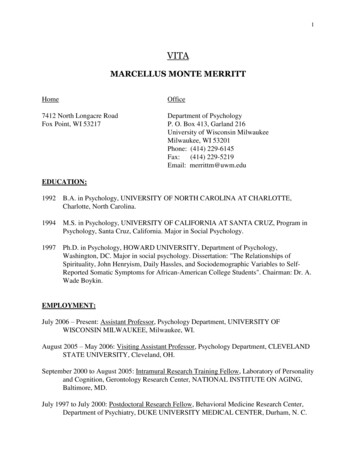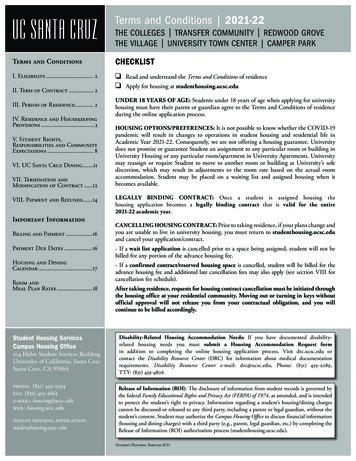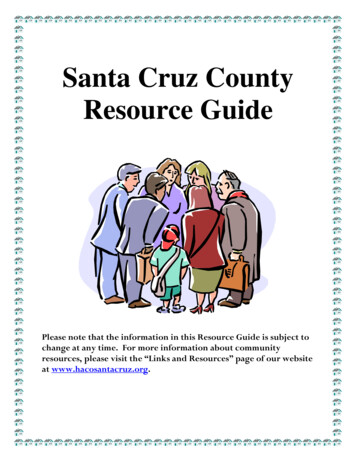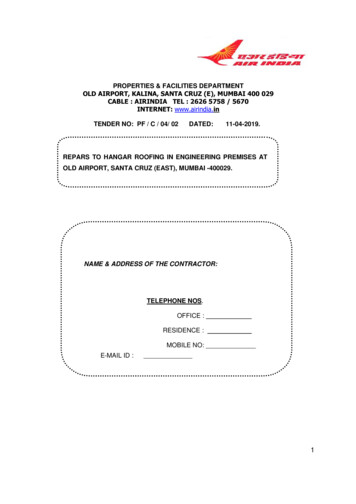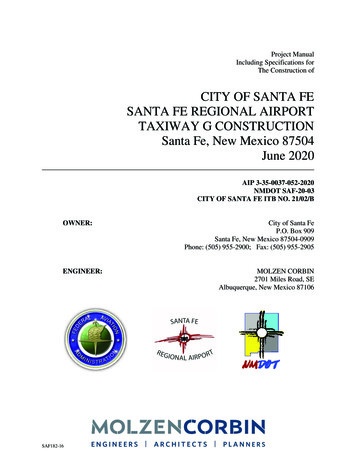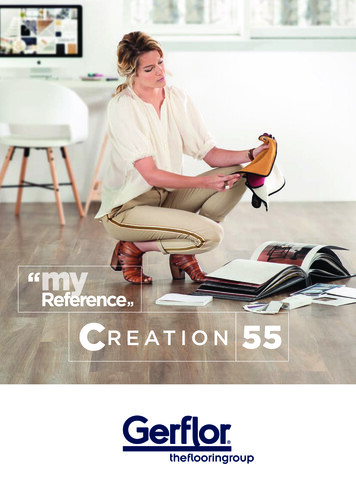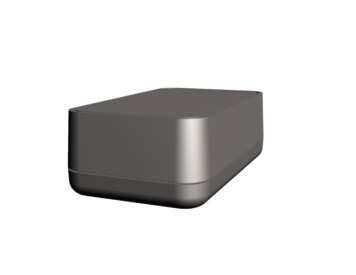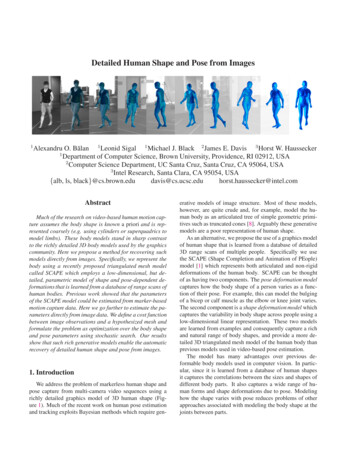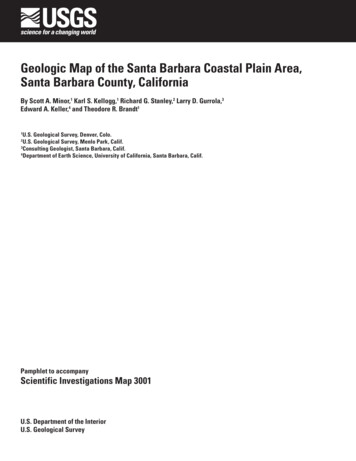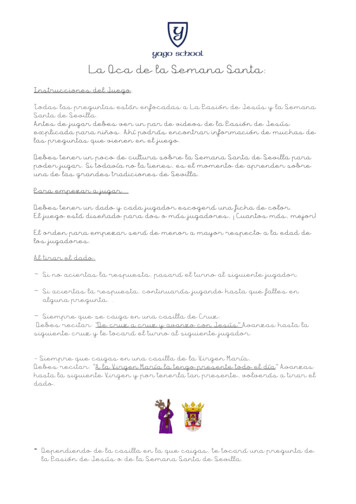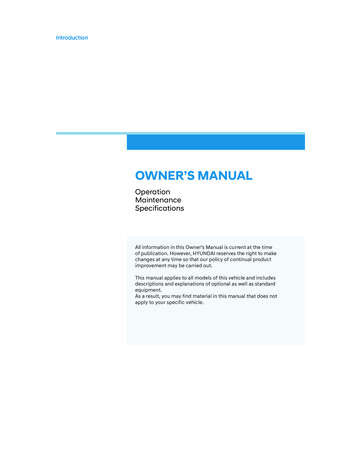
Transcription
Introduction1OWNER’S MANUALOperationMaintenanceSpecificationsAll information in this Owner’s Manual is current at the timeof publication. However, HYUNDAI reserves the right to makechanges at any time so that our policy of continual productimprovement may be carried out.This manual applies to all models of this vehicle and includesdescriptions and explanations of optional as well as standardequipment.As a result, you may find material in this manual that does notapply to your specific vehicle.
IntroductionCAUTION: MODIFICATIONS TO YOURHYUNDAIYour HYUNDAI should not be modified in any way. Such modifications mayadversely affect the performance, safety or durability of your HYUNDAIand may, in addition, violate conditions of the limited warranties coveringthe vehicle. Certain modifications may also be in violation of regulationsestablished by the U.S. Department of Transportation and other federal or stateagencies.7:2ǘ: 5 ',2 25 &(//8/ 5 TELEPHONE INSTALLATIONYour vehicle is equipped with electronic fuel injection and other electroniccomponents. It is possible for an improperly installed/adjusted two-way radioor cellular telephone to adversely affect electronic systems. For this reason, werecommend that you carefully follow the radio or cell phone manufacturer’sinstructions or consult your authorized HYUNDAI dealer for precautionarymeasures or special instructions if you choose to install one of these devices.F2
SAFETY AND VEHICLE DAMAGE WARNINGThis manual includes information titled as DANGER, WARNING, CAUTION andNOTICE.These titles indicate the following:DANGERDANGER indicates a hazardous situation which, if not avoided, will result indeath or serious injury.WARNINGWARNING indicates a hazardous situation which, if not avoided, could resultin death or serious injury.CAUTIONCAUTION indicates a hazardous situation which, if not avoided, could resultin minor or moderate injury.NOTICENOTICE indicates a situation which, if not avoided, could result in vehicledamage.F3
HYUNDAI VEHICLE OWNER PRIVACY POLICYYour Hyundai vehicle may be equipped with technologies and services that useinformation collected, generated, recorded or stored by the vehicle. Hyundaihas created a Vehicle Owner Privacy Policy to explain how these technologiesand services collect use and share this information.You may read our Vehicle Owner Privacy Policy on the Hyundaiusa.com websiteat: pxIf you would like to receive a hard copy of our Vehicle Owner Privacy Policy,please contact our Customer Care Center at:Hyundai Customer CareP.O. Box 20850Fountain Valley, CA 92728 800-633-5151consumeraffairs@hmausa.comHyundai’s Customer Care Center representatives are available Monday throughFriday,between the hours of 6:00 AM and 5:00 PM PST and Saturday between 6:30AM and 3:00 PM PST.For Customer Care assistance in Spanish or Korean, representatives areavailable Monday through Friday between 6:30 AM and 3:00 PM PST.
Table of contentsForeword1Vehicle Information, Consumer Information andReporting Safety Defects2Seats & Safety System3Instrument Cluster4Convenient Features5Driving your Vehicle6Driver Assistance System7Emergency Situations8Maintenance9IndexI
IntroductionFOREWORDCongratulations, and thank you for choosing HYUNDAI. We are pleased to welcomeyou to the growing number of discerning people who drive a HYUNDAI vehicle. We arevery proud of the advanced engineering and quality of each HYUNDAI we build.Your Owner’s Manual will introduce you to the features and operation of your newHYUNDAI. To become familiar with your new HYUNDAI, so that you can fully enjoy it,read this Owner’s Manual carefully before driving your new vehicle.This manual contains important safety information and instructions intended tofamiliarize you with your vehicle’s controls and safety features so you can safelyoperate your vehicle.This manual also contains information on maintenance designed to enhance safeoperation of the vehicle. It is recommended that all service and maintenance on yourcar be performed by an authorized HYUNDAI dealer. An authorized HYUNDAI dealer isprepared to provide high-quality service, maintenance and any other assistance thatmay be required.This Owner’s Manual should be considered a permanent part of your vehicle, andshould be kept in the vehicle so you can refer to it at any time. The manual should staywith the vehicle if you sell it to provide the next owner with important operating, safetyand maintenance information.HYUNDAI MOTOR AMERICACAUTIONSevere engine and transmission damage may result from the use of poor qualityfuels and lubricants that do not meet HYUNDAI specifications. You must always usehigh quality fuels and lubricants that meet the specifications listed on Page 2-14 inthe Vehicle Specifications section of the Owner’s Manual.Copyright 2021 HYUNDAI Motor America. All rights reserved. No part of this publicationmay be reproduced, stored in any retrieval system or transmitted in any form or by anymeans without the prior written permission of HYUNDAI Motor America.1-2
01GUIDE TO HYUNDAI GENUINE PARTS1. What are HYUNDAI Genuine Parts?HYUNDAI Genuine Parts are thesame parts used by HYUNDAI MotorCompany to manufacture vehicles.They are designed and tested for theoptimum safety, performance, andreliability for our customers.2. Why Hyundai Genuine Parts?HYUNDAI Genuine Parts areengineered and built to meet rigidmanufacturing requirements.Damage caused by using imitation,counterfeit or used salvage parts isnot covered under the HYUNDAI NewVehicle Limited Warranty or any otherHYUNDAI warranty.In addition, any damage to or failureof HYUNDAI Genuine Parts causedby the installation or failure of animitation, counterfeit or used salvagepart is not covered by any HYUNDAIWarranty.3. How can you tell if you arepurchasing HYUNDAI Genuine Parts?Look for the HYUNDAI Genuine PartsLogo on the package (see below).HYUNDAI Genuine Parts exportedto the U.S. are packaged with labelswritten only in English.HYUNDAI Genuine Parts are onlysold through authorized HYUNDAIDealerships.1-3
IntroductionHOW TO USE THIS MANUALWe want to help you get the greatest possible driving pleasure from your vehicle. YourOwner’s Manual can assist you in many ways. To gain an overview of the contentsof your Owner’s Manual, use the Table of Contents in the front of the manual. Thefirst page of each Chapter includes a detailed Table of Contents of the topics in thatChapter.To quickly locate information about your vehicle, use the Index in the back of themanual. It is an alphabetical list of what is in this manual and the page number where itcan be found.For your convenience, we have incorporated tabs on the right-hand page edges.These tabs are coded with the Chapter titles to assist you with navigating through themanual.SAFETY MESSAGESYour safety, and the safety of others, is very important. This Owner’s Manual providesyou with many safety precautions and operating procedures. This information alertsyou to potential hazards that may hurt you or others, as well as damage your vehicle.Safety messages found on vehicle labels and in this manual describe these hazardsand what to do to avoid or reduce the risks.Warnings and instructions contained in this manual are for your safety. Failure to followsafety warnings and instructions can lead to serious injury or death.Throughout this manual DANGER, WARNING, CAUTION, NOTICE and the SAFETYALERT SYMBOL will be used.This is the safety alert symbol. It is used to alert you to potential physical injuryhazards. Obey all safety messages that follow this symbol to avoid possibleinjury or death. The safety alert symbol precedes the signal words DANGER,WARNING and CAUTION.DANGERDANGER indicates a hazardoussituation which, if not avoided, willresult in death or serious injury.WARNINGWARNING indicates a hazardoussituation which, if not avoided, couldresult in death or serious injury.1-4CAUTIONCAUTION indicates a hazardoussituation which, if not avoided, couldresult in minor or moderate injury.NOTICENOTICE indicates a situation which,if not avoided, could result in vehicledamage.
01FUEL REQUIREMENTSGasoline engineUnleaded Fuel OnlyYour new vehicle is designed to perform optimally using unleaded fuel having anoctane number ((R M)/2) of 87 (Research Octane Number 91) or higher. (Do not usemethanol blended fuels)Your new vehicle is designed to obtain maximum performance with UNLEADED FUEL,as well as minimize exhaust emissions and spark plug fouling.NOTICETo prevent damage to the engine and engine components, never add any fuelsystem cleaning agents to the fuel tank other than what has been specified.Consult an authorized HYUNDAI dealer for additional information.WARNING Do not “top off” after the nozzle automatically shuts off when refueling. Always check that the fuel cap is installed securely to prevent fuel spillage in theevent of an accident.Gasoline containing alcohol and methanolGasohol, a mixture of gasoline and ethanol (also known as grain alcohol) are beingmarketed along with or instead of leaded or unleaded gasoline. For example, “E15” is agasohol comprised of 15% ethanol and 85% gasoline.Do not use gasohol containing more than 15% ethanol, and do not use gasoline orgasohol containing any methanol. Either of these fuels may cause drivability problemsand damage to the fuel system, engine control system and emission control system.Discontinue using gasohol of any kind if drivability problems occur.“E85” fuel is an alternative fuel comprised of 85 percent ethanol and 15 percentgasoline, and is manufactured exclusively for use in Flexible Fuel Vehicles. “E85” isnot compatible with your vehicle. Use of “E85” may result in poor engine performanceand damage to your vehicle’s engine and fuel system. HYUNDAI recommends thatcustomers do not use fuel with an ethanol content exceeding 15 percent.NOTICETo prevent damage to your vehicle’s engine and fuel system: Never use gasohol which contains methanol. Never use gasohol containing more than 15% ethanol. Never use leaded fuel or leaded gasohol. Never use “E85” fuel.Your New Vehicle Limited Warranty does not cover damage to the fuel system or anyperformance problems caused by the use of “E85” fuel.1-5
IntroductionUsing Fuel Additives (except Detergent Fuel Additives)Using fuel additives such as:- Silicone fuel additive- Ferrocene (iron-based) fuel additive- Other metallic-based fuel additivesMay result in cylinder misfire, poor acceleration, engine stalling, damage to thecatalyst, or abnormal corrosion, and may cause damage to the engine resulting in areduction in the overall life of the powertrain.- The Malfunction Indicator Lamp (MIL) may illuminate.NOTICEDamage to the fuel system or performance problem caused by the use of these fuelsmay not be covered by your New Vehicle Limited Warranty.Gasoline containing MMTSome gasoline contains harmful manganese-based fuel additives such as MMT(Methylcyclopentadienyl Manganese Tricarbonyl).HYUNDAI does not recommend the use of gasoline containing MMT.This type of fuel can reduce vehicle performance and affect your emission controlsystem.The malfunction indicator lamp on the cluster may come on.Detergent Fuel AdditivesHYUNDAI recommends that you use good quality gasolines treated with detergentadditives such as TOP TIER Detergent Gasoline, which help prevent deposit formationin the engine. These gasolines will help the engine run cleaner and enhanceperformance of the Emission Control System. For more information on TOP TIERDetergent Gasoline, please go to the website (www. toptiergas.com).For customers who do not use TOP Tier Detergent Gasoline regularly, and haveproblems starting or the engine does not run smoothly, detergent-based fuel additivesthat you can purchase separately may be added to the gasoline. If TOP TIER DetergentGasoline is not available, one bottle of additive added to the fuel tank according to themaintenance schedule is recommended (refer to the Maintenance Schedule in chapter9).Additives are available from your authorized HYUNDAI dealer along with informationon how to use them. Do not mix other additives.Operation in foreign countriesIf you are going to drive your vehicle in another country, be sure to: Observe all regulations regarding registration and insurance. Determine that acceptable fuel is available.1-6
01VEHICLE MODIFICATIONS This vehicle should not be modified. Modification of your vehicle could affect itsperformance, safety or durability and may even violate governmental safety andemissions regulations.In addition, damage or performance problems resulting from any modification maynot be covered under warranty. If you use unauthorized electronic devices, it may cause the vehicle to operateabnormally, wire damage, battery discharge and fire. For your safety, do not useunauthorized electronic devices.NOTICESome warning sounds (including welcome/good-bye sound, etc.) are generatedfrom the interior speakers or amplifiers. If necessary, we recommend you topurchase HYUNDAI Part to replace an interior speaker or amplifier. Any unauthorizedproduct may cause a malfunction of the interior speakers or amplifiers.9( ,&/( %5( .ǘ,1 352&(66By following a few simple precautions for the first 600 miles (1,000km) you may add tothe performance, economy and life of your vehicle. Do not race the engine. While driving, keep your engine speed (RPM, or revolutions per minute) between2,000 RPM and 4,000 RPM. Do not maintain a single speed for long periods of time, either fast or slow. Varyingengine speed is needed to properly break-in the engine. Avoid hard stops, except in emergencies, to allow the brakes to seat properly. Fuel economy and engine performance may vary depending on vehicle break-inprocess and be stabilized after 4,000 miles (6,000 km). New engines may consumemore oil during the vehicle break-in period. Do not tow a trailer during the first 1,200 miles (2,000km) of operation.WARNINGCALIFORNIA PROPOSITION 65 WARNINGItems contained in motor vehicles or emitted from them are known to the State ofCalifornia to cause cancer and birth defects or reproductive harm. These include: Gasoline and its vapors Engine exhaust Used engine oil Interior passenger compartment components and materials Component parts which are subject to heat and wearIn addition, battery posts, terminals and related accessories contain lead, leadcompounds and other chemicals known to the State of California to cause cancerand reproductive harm.For more information go to 7
IntroductionVEHICLE DATA COLLECTION AND EVENT DATA RECORDERSThis vehicle is equipped with an event data recorder (EDR). The main purpose ofan EDR is to record, in certain crash or near crash-like situations, such as an air bagdeployment or hitting a road obstacle, data that will assist in understanding how avehicle’s systems performed. The EDR is designed to record data related to vehicledynamics and safety systems for a short period of time, typically 30 seconds or less.The EDR in this vehicle is designed to record such data as: How various systems in your vehicle were operating; Whether or not the driver and passenger safety belts were buckled/fastened; How far (if at all) the driver was depressing the accelerator and/or brake pedal; and, How fast the vehicle was traveling.These data can help provide a better understanding of the circumstances in whichcrashes and injuries occur. NOTE: EDR data are recorded by your vehicle only if anon-trivial crash situation occurs; no data are recorded by the EDR under normaldriving conditions and no personal data (e.g., name, gender, age, and crash location)are recorded. However, other parties, such as law enforcement, could combine theEDR data with the type of personally identifying data routinely acquired during a crashinvestigation.To read data recorded by an EDR, special equipment is required, and access to thevehicle or the EDR is needed. In addition to the vehicle manufacturer, other parties,such as law enforcement, that have the special equipment, can read the information ifthey have access to the vehicle or the EDR.1-8
2. Vehicle Information,Consumer Information andReporting Safety DefectsExterior Overview (I) .2-2Exterior Overview (II) .2-3Interior Overview . 2-4Instrument Panel Overview (I) . 2-5Instrument Panel Overview (II) . 2-6Engine Compartment .2-7Dimensions. 2-8Engine . 2-8Bulb Wattage. 2-9Tires and Wheels .2-10Air Conditioning System .2-11Gross Vehicle Weight .2-11Recommended Lubricants and Capacities . 2-12Recommended SAE Viscosity Number .2-13Vehicle Identification Number (VIN) . 2-14Vehicle Certification Label . 2-14Tire Specification and Pressure Label . 2-14Engine Number . 2-15Refrigerant Label . 2-15Consumer Information . 2-16Reporting Safety Defects . 2-172
Vehicle Information, Consumer Information and Reporting Safety Defects(;7(5,25 29(59,(: ǣ,Ǥ Front viewThe actual shape may differ from the illustration.ONX4OB0110011. Hood . 5-645. Sunroof . 5-592. Front lamps .9-586. Front windshield wiper blades . 9-283. Tires and wheels . 9-357. Windows . 5-544. Side view mirror. 5-528. Front radar . 7-142-2
02(;7(5,25 29(59,(: ǣ,,Ǥ Rear viewThe actual shape may differ from the illustration.ONX4OB0110021. Door handle .5-328. Rear view camera .7-1112. Fuel filler door .5-689. Rear bumper step .5-683. Rear combination lamp.9-6010. Reverse lamp . 9-624. Tailgate . 5-6511. Underbed storage.5-1195. High mounted stop lamp /Top mounted bed lamp . 9-6212. Sidewall storage .5-1216. Tonneau cover .5-11414. Fixed tie downs. 5-1227. Antenna . 5-13215. D-ring tie downs . 5-12213. Rail and cleat system . 5-1232-3
Vehicle Information, Consumer Information and Reporting Safety DefectsINTERIOR OVERVIEWThe actual shape may differ from the illustration.ONX4OB0110031. Inside door handle. 5-347. Bed lamp ON/OFF Switch .5-812. Power window switches . 5-548. ESC OFF Switch . 6-393. Power window lock button .5-579. Steering wheel . 5-394. Outside rearview mirror controlswitch . 5-5310. Steering wheel tilt/telescopic lever .5-405. Driver door lock switch . 5-3512. Hood release lever. 5-646. Instrument panel illumination controlswitch . 4-513. Seat. 3-32-411. Fuse box .9-48
02,167580(17 3 1(/ 29(59,(: ǣ,ǤThe actual shape may differ from the illustration.ONX4OB0110041. Instrument cluster . 4-412. Parking/View button . 7-1122. Driver’s front air bag. 3-4213. EPB (Electronic Parking Brake)switch . 6-303. Key ignition switch/ . 6-5Engine Start/Stop button . 6-814. Auto Hold switch . 6-344. Infotainment system . 5-13215. AWD lock button .6-515. Hazard warning lamp switch . 8-216. Drive mode switch .6-486. Climate control system .5-85/5-9317. Passenger’s front air bag . 3-427. Air ventilation seat .3-1818. Glove box .5-1138. Seat warmer .3-1619. USB port . 5-1329. Heated steering wheel .5-4020. Power outlet. 5-12510. Transmission shift lever. 6-14/6-2121. USB charger . 5-12611. DBC button .6-4422. Wireless charging system pad . 5-1272-5
Vehicle Information, Consumer Information and Reporting Safety Defects,167580(17 3 1(/ 29(59,(: ǣ,,ǤThe actual shape may differ from the illustration.ONX4OB0110051. Lighting control lever . 5-716. Bluetooth hands-free phone button. 5-1342. Wiper and washer control lever. 5-827. LCD display control .4-273. Paddle shifter .6-198. Lane Driving Assist button . 7-314. Voice recognition button . 5-1349. Driving Assist button . 7-565. Audio remote control buttons . 5-13410. Vehicle Distance button . 7-772-6
02ENGINE COMPARTMENT Smartstream G2.5 GDI Smartstream G2.5 TGDIThe actual engine compartment in the vehicle may differ from the illustration.ONX4OB091016/ONX4OB0910011. Engine coolant reservoir . 9-206. Windshield washer fluid reservoir . 9-242. Brake fluid reservoir . 9-237. Fuse box .9-493. Air cleaner . 9-258. Battery .9-314. Engine oil dipstick . 9-175. Engine oil filler cap (2.5 T-GDI’s fillercap is under the engine cover) . 9-172-7
Vehicle Information, Consumer Information and Reporting Safety DefectsDIMENSIONSItemsOverall lengthOverall widthOverall heightin (mm)195.67 (4,970)75 (1,905)66.73 (1,695)Front64.69 (1,643)TreadWheelbaseRear64.88 (1,648)118.30 (3,005)ENGINEEngineSmartstream G 2.5 GDISmartstream G 2.5 TGDI2-8Displacementcu. in (cc)152.4(2,497)Bore x StrokeFiring order No. of cylindersin. (mm)3.5 x 4(88.5 x 101.5)1-3-4-24, in-line
02BULB WATTAGELight bulbHeadlampType ABulb typeWattageHighHB360LowHB360LEDLEDDaytime running lamp (DRL) /Position lampTurn signal lampPY28W28LEDLEDHighLEDLEDLowSide markerFrontHeadlampLEDLEDDaytime running lamp (DRL) /Position lampLEDLEDTurn signal lampLEDLEDSide markerLEDLEDSide repeater lamp (Outside mirror)LEDLEDTail lamp (Inside)LEDLEDTail lamp (Outside) / Side MarkerLEDLEDType BRearTurn signal lamp/ Stop LampP21W21Reverse lampW16W16License plate lampW5W5High mounted stop lampLEDLEDTop Mounted Bed LampLEDLEDSide mounted Bed LampLEDLEDW10W10Map lampInteriorBulb typeLED typeLEDLEDBulb typeFESTOON10LED typeLEDLEDGlove box lampW5W5Sunvisor lampFESTOON5Room lamp2-9
Vehicle Information, Consumer Information and Reporting Safety DefectsTIRES AND WHEELSItemsTire sizeWheelsizeInflation pressure psi (kPa)Normal loadMaximum loadFrontRearFrontRearFull size tire245/60 R18245/50 R207.5J X 187.5J X 2035 (240)T135/80 D18 4.0T x 1860 (420)Compactspare tireWheel nuttorque lbf·ft(kgf·m, N·m)79 94(11 13)NOTICE It is permissible to add 3 psi to the standard tire pressure specification if coldertemperatures are expected soon.Tires typically lose 1psi (7kPa) for every 12 F temperature drop. If extremetemperature variations are expected, recheck your tire pressure as necessary tokeep them properly inflated. Tire inflation pressures will vary with changes in elevation. If driving in areas ofhigher or lower elevation, be sure to check and adjust for proper tire inflation.CAUTION When replacing tires, use the same size originally supplied with the vehicle.Using tires of a different size can damage the related parts or not work properly. When replacing tires, ALWAYS use the same size, type, construction and treadpattern supplied with the vehicle for all tires.2-10
02AIR CONDITIONING SYSTEMItemsRefrigerantoz. (g)Weight of volumeClassification21.16 (600) 0.88 (25)R-1234yfCompressor lubricant3.5273 (100) 0.35 (10)oz. (g)Contact an authorized HYUNDAI dealer for more details.PAGGROSS VEHICLE WEIGHTSmartstream G2.5 GDi2WDAWDItemsGross vehicle weightlbs. (kg)5,456(2,475)5,610(2,545)Smartstream G2.5 TGDi2WDAWD5,577(2,530)5,732(2,600)2-11
Vehicle Information, Consumer Information and Reporting Safety DefectsRECOMMENDED LUBRICANTS AND CAPACITIESTo help achieve proper engine and powertrain performance and durability, use onlylubricants of the proper quality. The correct lubricants also help promote engineefficiency that results in improved fuel economy.These lubricants and fluids are recommended for use in your vehicle.LubricantEngine oil *1(drain and refill)RecommendsVolumeSmartstreamG2.5 GDISmartstreamG2.5 T-GDIDual clutchtransmissionfluidCoolant0W-20 SN PLUS/SP orILSAC GF-6 *26.13 US qt. Ţ6.87 US qt. ŢAutomatic transmission fluid3.49 3.59US qt.(3.3 3 ŢSmartstreamG2.5 T-GDI2.59 2.64ControlUS qt.oil(2.45 2.50 ŢSmartstream10.00 US qt.G2.5 GDI ŢGear oilSmartstreamG2.5 T-GDI9.12 US qt. ŢBrake fluidAs requiredRear differential oil (AWD)0.56 0.67US qt. a Ţ)Transfer caseoil (AWD)ClassificationSmartstreamG2.5 GDI0.66 0.72US qt. a ŢSmartstreamG2.5 T-GDI0.51 0.55US qt. a Ţ0W-30 SN PLUS/SP orILSAC GF-6 *2MICHANG ATF SP-IV, SKATF SP-IV, NOCA ATF SP-IV,HYUNDAI genuine ATF SP-IVor other brands meeting theabove specification approved byHYUNDAI Motor Co.GS WDCTF HD G (WDGO-1)GS WDCTF HD H (WDHO-1)MIXTURE, Antifreeze with water(Ethylene glycol base coolant foraluminum radiator)SAE J1704 DOT-4 LV, FMVSS 116DOT-4, ISO4925 CLASS-6HYPOID GEAR OIL API GL-5, SAE75W/85 (SK HCT-5 GEAR OIL75W/85 or EQUIVALENT)17.69 US gal Refer to “Fuel requirements” Ţin chapter 1.*1 : Refer to the recommended SAE viscosity numbers.*2 : Requires API Latest (or ILSAC Latest) Full synthetic grade engine oil. If a lower gradeengine oil (mineral oil including Semi-synthetic) is used, then the engine oil and engineoil filter must be replaced as indicated severe maintenance condition.Fuel2-12
02Recommended SAE Viscosity NumberCAUTIONAlways be sure to clean the area around any filler plug, drain plug, or dipstick beforechecking or draining any lubricant. This is especially important in dusty or sandyareas and when the vehicle is used on unpaved roads. Cleaning the plug and dipstickareas will prevent dirt and grit from entering the engine and other mechanisms thatcould be damaged.Engine oil viscosity (thickness) has an effect on fuel economy and cold weatheroperating (engine start and engine oil flowability). Lower viscosity engine oils canprovide better fuel economy and cold weather performance, however, higher viscosityengine oils are required for satisfactory lubrication in hot weather. Using oils of anyviscosity other than those recommended could result in engine damage.When choosing an oil, consider the range of temperature your vehicle will be operatedin before the next oil change. Proceed to select the recommended oil viscosity fromthe chart.TemperatureEngine Oil *1*1 :Temperature Range for SAE Viscosity Numbers C-30-20 -1001020( F)SmartstreamG2.5 GDISmartstreamG2.5 T-GDI-100204060308040501001200W-200W-30Requires API SN PLUS (or above) Full synthetic grade engine oil. If a lower gradeengine oil (mineral oil including Semi-synthetic) is used, then the engine oil and engineoil filter must be replaced as indicated for severe maintenance condition
Owner's Manual can assist you in many ways. To gain an overview of the contents of your Owner's Manual, use the Table of Contents in the front of the manual. The first page of each Chapter includes a detailed Table of Contents of the topics in that Chapter. To quickly locate information about your vehicle, use the Index in the back of the .
